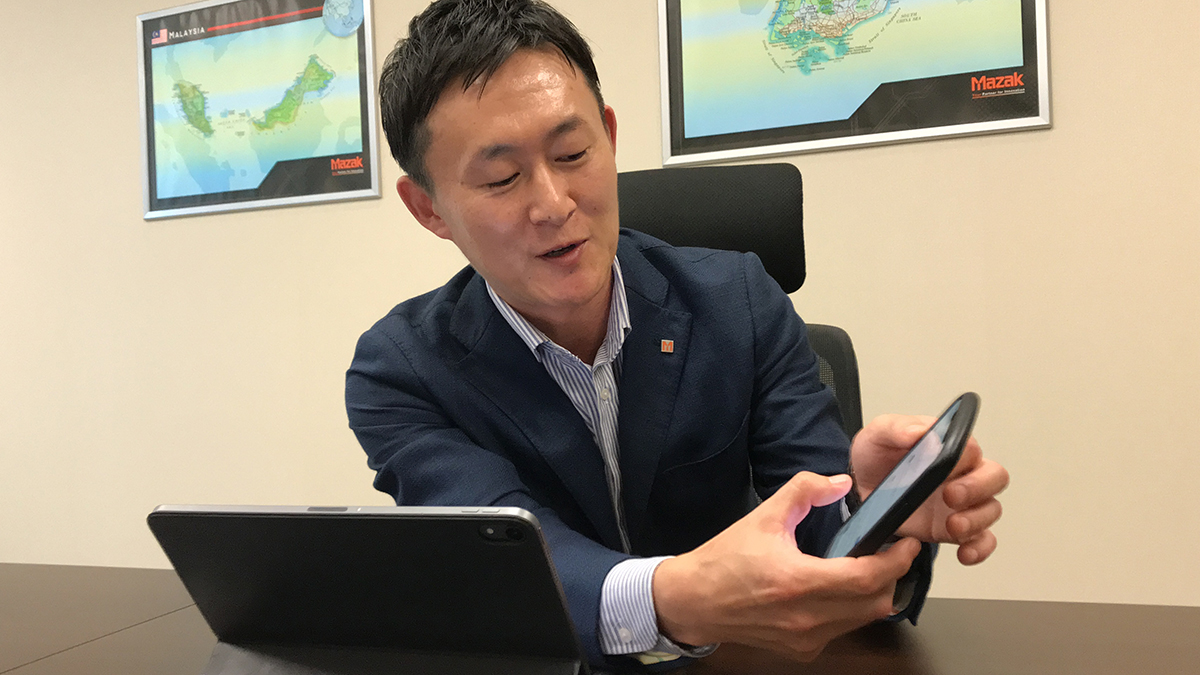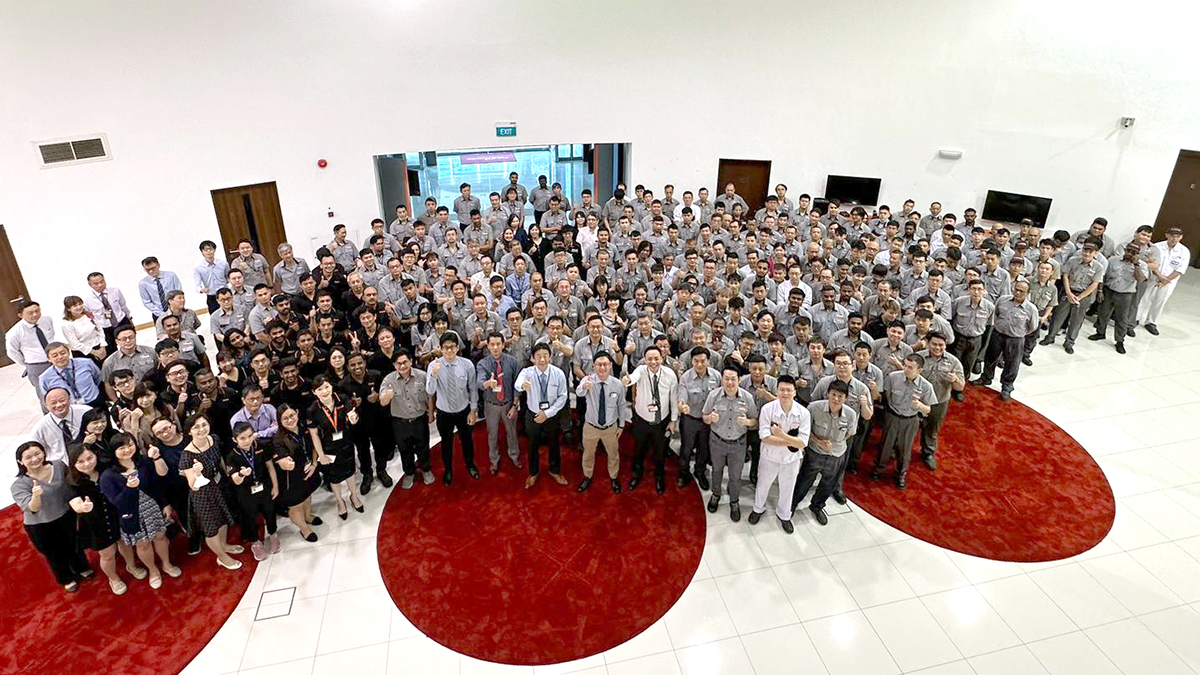Yamazaki Mazak Singapore Pte Ltd
- HOME
- Success Stories
- Yamazaki Mazak Singapore Pte Ltd
Turn business card information into corporate assets
Creating new ways of sales by visualizing customer contacts beyond borders

Yamazaki Mazak Corporation develops, manufactures , sells, and exports computer numerical control (CNC) machine tools, automation systems, production support software, and laser cutting machines. The company has 11 production plants and support centers in 87 locations worldwide. Its subsidiary, Yamazaki Mazak Singapore Pte Ltd, introduced Sansan in five countries: Singapore, Malaysia, Thailand, Vietnam, and Indonesia. We interviewed them about the impact of making a business cardand contact information a shared asset between each location, along with key points for managing the system.
Objectives
- Turn business card information into corporate assets
- Strengthen sales abilities by sharing information of customer and sales activities
- Efficiently manage business projects
Challenges faced
- Contact information is managed individually, making it difficult to share
- Lack of an information sharing platform within the ASEAN region
- Time-consuming management of business project figures and status
Results
- Created a customer contact database and visualized internal human networks
- Created business opportunities through increased information sharing
- Real-time, efficient management of business project information
Even if a person in charge leaves their post,
we can still maintain the business opportunities
[ Interviewee ]
Deputy Managing Director / Mr. Tatsuro Moriyama

We started with the idea of utilizing highly personalized business card information as a corporate asset.
– Deputy Managing Director Mr. Tatsuro Moriyama
Business overview
Yamazaki Mazak Corporation is one of the biggiest machine tool manufacturer headquartered in Oguchi-cho, Niwa-gun, Aichi Prefecture, Japan. The company offers a broad product lineup of CNC lathes, machining centers, laser cutting machines, multi-tasking machines, five-axis processing machines, and hybrid processing machines, as well as various solutions such as automation and IoT implementation. It has approximately 8,700 employees in Japan and overseas, as well as 11 production plants and support centers in 87 locations worldwide. Of these, Yamazaki Mazak Singapore Pte Ltd functions as a regional headquarters for the Southeast Asia and India markets.
Turn highly personalized business card information into corporate assets
We started using the Sansan contact management solution in May 2022. We implemented it because I was transferred to the Singapore subsidiary as Deputy Managing Director about half year before that. I was assigned as the Executive Supervisor of the Southeast Asia and India markets, but I have no idea the daily activities of salespeople in each country, or how we were dealing with our customers. So, we started with an attempt to utilize highly personalized business card contact information, which each sales representative had handled individually, as a corporate asset.
Creating a database of this contact information begins with scanning business cards using a dedicated scanner or a smartphone camera. It’s not just about reading the information on the card; the systems also records when and by whom and in which department the data was entered (position and title). This makes it clear exactly who oversaw the business. And even if the person is transferred internally, we can maintain the contact and the related business opportunities.
If we know that we already have contacts with a certain company in a certain country,
we may be able to further expand our business in our other overseas locations.
Visualization of customer contact information provides an opportunity to leverage human networks
For clients with multinational operations, the effect is even greater – beyond national borders. Contact information is structured so we can see, at a glance, which customer was contacted, when, and by whom. This is shown in the organization chart/tree. We can leverage the previously unseen information on sales representatives’ past contacts and executives’ personal connections. If we know that we already have contacts with a certain company in a certain country, we may be able to further expand our business in our other overseas locations through requests for introductions.
Report function: Create new ways of selling by sharing business meeting information
We can also find further possibilities by entering in reports on when and what kind of business meetings were held. We’ve implemented a practice where we always associate business meetings with the relevant contacts and enter in the details on what happened in the meetings. We use a format that lets us input whether this concerns a new or existing customer, the nature of the discussion, and whether any follow-up actions are required.
Actually, we recently had a case where we saw how effective it is to share meeting information in this way. Our sales representative in Indonesia was working with a prospective client, but he couldn’t do enough to convince them. Just as we were thinking that it might be too hard to close the deal, we found a report that showed we’d signed a contract with a related group company in Thailand. We thought it might be helpful to share this information. Although sales representatives from Indonesia and Thailand normally have little contact with each other, they began to keep in touch, and this helped them more deeply understand this client.
Above all, we gained an awareness of the new types of business development that we can realize through such information sharing.

Information sharing among departments that have little contact with each other has helped us recognize new ways of developing business
Managers are taking the initiative in responding to reports,
which helps boost information sharing throughout the organization.
Message function: Use as a communication tool
As we’ve used Sansan, we’ve also come to appreciate how useful many of its other features are, like the messaging function. Reports are designed so they’re immediately reflected in the database after they’re entered. And they’re shared with managers and higher roles in real time. Managers can also leave comments, such as advice, on the reports. It’s like a teacher writing a comment on a student’s report.
Even if there’s no comment, the “thumbs-up” can be used to express “nice work”, like how it’s used in social media. The sales representative also may not be motivated if there’s no reaction or response to their report. Implicitly conveying “we’re paying attention” helps boost information sharing throughout the organization.
Early in the implementation, managers, including myself, took the initiative in scanning in cards, entering comments, and clicking “thumbs-up.” Sales representatives who at first were reluctant or unsure of how to input the information gradually got used to the system and began to realize its benefits. The system is now firmly established in our company.
Can realize real-time numerical and status management of each case or project
The project management function in Sansan is another feature we actively use. This lets us manage information on a project-by-project base, so we can track the progress of specific cases and make predictions on potential orders for the upcoming months. This function helps us manage sales activities.
Until now, there was no existing platform for business management in ASEAN. Consolidating and managing business information from multiple countries meant conducting interviews in each country, which took a lot of time. But we’ve now implemented a system where sales representatives input the latest information in a standardized format we can use across countries. This enables instant data aggregation and efficient management.
Again recognizing the importance of visualizing and sharing information in business
Being able to grasp the status of business in real time is very important for management. Daily business activities tend to remain only with the person in charge until a certain status is reached, such as consolidated into a report. This isolation can often lead to a negative spiral, and valuable opportunities may be missed when they could have been seen with just a small hint or word of advice.
In such situations, it’s not uncommon for guidance or information from superiors to help in overcoming obstacles. Sansan is a great way to strengthen the sales force as a whole team.
It’s crucial to establish a solid platform for information sharing with
all national staff as we speed up development of overseas markets.
All national staff communicate on the same platform
We’ve implemented and are using Sansan in five countries in Southeast Asia, which fall under the jurisdiction of the Singapore regional headquarters. A total of 26 staff, including Japanese, are responsible for entering business card information and comments. The staff in each country continue to routinely input data on their daily business activities.
We were one of the first companies to expand our business overseas, and our overseas sales account for a high percentage of our total sales. As we continue to speed up development of overseas markets, it’s very important to establish a solid platform for information sharing with all our national staff. Being able to easily adjust the system to be local-userfriendly for national staff also earns high marks. All input forms for reports and project information are unified in English, and product information is entered in advance to reduce sales representatives’ input burden as much as possible.
This year marks 20 years since I joined Yamazaki Mazak. After working in domestic sales, I was stationed in India in 2011 and Thailand in 2016. In those assignments, I was involved in sales activities on the front line, so it may have been natural that I wasn’t so conscious of sharing information. Then, in December 2021, when I arrived at the Singapore headquarters as Deputy Managing Director, I was faced with various problems. I wasn’t able to see what each country’s subsidiaries and offices were doing, and the work being done wasn’t visible. I was puzzled about how to deal with this situation.
That’s when I found Sansan. At first, I could only think of the limited use for business card management, but with the after-sales support, the other benefits I spoke about became clear. We’re looking forward to further expansion of Sansan’s functions in the future.

Yamazaki Mazak Singapore’s staff
※This article was created in June 2023